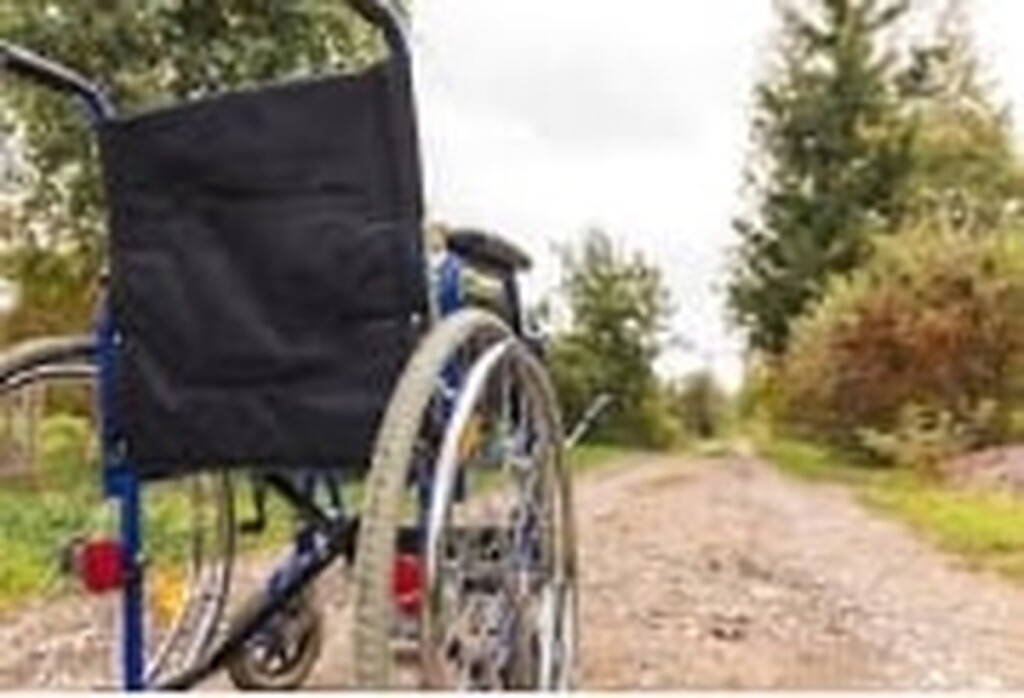The federal government guarantees PWDs equal access, but leaves the way perilous, and the means forbidding
By Olusegun Elijah
At Merfadan, a petrol generator powers the production plant of an open-air factory hedging the quadrangle at the Ondo Plaza, Trade Fair. Bags and buckets brimming with jumbles of metals squat about the ground. His hand in the morning air, the CEO, a handyman, swears to God, and repeats his company’s Africa-wide mission statement printed only in his heart.
Kingsley Gilbert’s current market comprises government, and Super Parents Foundation among other NGOs. But the global market he operates in remains generally poorly served: 130 million people around the world need the product to make their lives easy and independent of others. The World Health Organisation says only 10 percent of the millions get the appropriate merchandise. And that happens in the highly resourced environments—like the US and Europe.
A bigger bulk of the unmet needs exists on this side of the Pond. A fraction of the users even have to pay through their noses to get scraps coming from the West and Europe.
Abdulwahab Matepo, the chairman of the Spinal Cord Injury Association (SCIAN) in Lagos, says 25 percent of his cluster don’t have any wheelchair. “About 50 percent have just one.” Which limits their mobility and increase their dependence when its breaks down.
Policies account for this difference between the haves in the wealthy nations, and the have-ones in Nigeria, a less-resourced environment.

Matepo
The ministry of health collaborated with that of humanitarian affairs and the disability communities to put together the Priority Assistive Technology Product List last March. The wheelchair is among the devices the Global Cooperation on Assistive Technology (GATE) document by WHO listed originally in 2016. Nigeria rehashed this to achieve the nearest to anything that can be called a policy for such product specifications. The Discrimination Act 2018 enacted four years earlier, with its provision for equal access, hasn’t achieved anything close to specification, either.
Specifications, however, matters nothing to most wheelchair users: people with physical disabilities, including polio survivors; people with CP spectrum; amputees; and the elderly. Getting one to take them from A to B matters more.
But the mobility device means a lot more than careening on wheels.
“A wheelchair meets the user’s needs and environmental conditions; provides proper fit and postural support; is safe and durable; is available in the country; and can be obtained and maintained and services sustained in the country at the most economical and affordable price,” WHO says.

Donated imported wheelchair
It requires some knowing, too. Kate Davis-otto, an Abuja based international wheelchair professional and physiotherapist, was among experts WHO selected to develop the wheelchair education package. “It’s the bedrock to providing the right wheelchair, right fit at the right time to prevent further injury and increase independence and inclusion,” she says.
The wheelchair also boasts of more: its own field, bio-medical engineering; a body, the International Society of Wheelchair Professionals; researchers; and a global manufacture standard ISO 7176. This is a 32-part series of development in ‘wheelchairing’, which include static and dynamic stability, effective braking, impact and fatigue strengths, obstacle climbing ability and wheeled mobility devices for use as seats in motor vehicles.
And, for all the science and technology that goes into it, the wheelchair costs a fortune, off the line.
“Honestly, how many of our people can afford a new wheelchair, including me,” Susan Kelechi, a polio survivor and disability advocate in Lagos, says. She and Matepo, in separate interviews, confirm most of the wheelchairs Nigerians use are substandard. “Some are second-grade and even third-grade wheelchairs imported in parts from Germany and the US, which are now assembled in Nigeria,” Matepo says. All the 10 he has used in the two decades after his spine-breaking auto-crash are all imported, fairly used—except the two he got as donations. Christiana Ifeanyi, a petty trader in Lagos, has used seven in 16 years—all second-hand, imported. Even the ones do-gooders and government donate are imported or sourced from importers and assemblers who knock up odds and ends shipped in from Germany and other countries to make whole wheelchairs. The Wheelchairs Foundation, a global charity, has donated 1400 wheelchairs, directly imported, to users in Nigeria so far. No consideration for terrain and users’ bodies in most of the importation. Some of the wheelchairs’ features—stoppers, neck-rest adjusters, and others ISO 7176 prescribes—might also be missing. Wheelchair Incorporation, a major seller in Lagos, has yet to respond to questions on standard and regulations for this story. For the desperate users, the ricketier a wheelchair comes, the cheaper it gets.

Ifeanyi
When Ifeanyi adds up all she spent to buy and repair the seven SOPUR brands she has used so far, the total stands at N508,000. She prefers the imported German wheelchair, no matter how tacky it comes.
Gilbert says he targets a different market—people like him, a father of a child with CP. “It’s not a good experience,” he says, talking about the cost of caring for his daughter, 11. And how that necessity gave birth to the “invention” of a wheelchair brand—by a generator repairman trying anything to make life easy for his daughter.
He says many parents like that find it difficult to add the cost of buying wheelchairs to their burden of caring for children with CP. If his memory serves him right, he, on several occasions, marked down his product below 70 per cent for many parents like that. A mother abandoned by her husband once pleaded to be contributing for a wheelchair in bits. “After three months, she called me begging I should return her money,” he recalls. He understood. And he returned her money.
“If government or people help us (not like he has partners or even a clerk), we can do mass production, and achieve a 50 percent reduction in price, which is our target.”
The ATP document proposes local production—because a standard definition of a wheelchair includes availability in a user’s country at affordable rate of acquisition and maintenance. That might have driven Humanitarian Affairs Minister Sadiyyat Farouq to have assembled in Kogi, last year, over a hundred artisans and iron benders who claim to manufacture wheelchairs locally. And the idea of stimulating local production became a brainwave. And before it all iced over, Ahmadi Aminu Tudun-Wada, a manufacturer from Kano, got a grant of N250,000 from the ministry. Thirty-five others did, too.
Operating in his own world, Gilbert got about the same amount as seed funding from Super Parents. The CP-focused NGO supported him because he didn’t beat it after his wife gave birth to their first child with congenital deformities.

Merfadan wheelchairs made in Lagos
But the SCIAN chairman still hugs his doubt. He insists neither these nor any others manufacture wheelchairs in Nigeria. The source he knows, which he says government also patronizes when donating wheelchairs to PWD clusters, merely assemble imported parts. He believes what Gilbert and Tundun-Wada manufacture, hand-pedaled trikes, are not wheelchairs. “We are the primary users of wheelchairs in Nigeria; we are not aware of local producers yet.” According to him, those contraptions are not tailor-made, and cannot be used in most places, especially indoors, and on hospital premises.
The CEO of Macferden will argue this. “I have produced and supplied to government and foundations and people over 100 wheelchairs since Dec. 2020. I go to their houses to take their measurements,” he says. Facing his own business, he doesn’t care to know what his competitors do. He’s not even aware of any competition—just as he never heard of the Kogi conference.
The local manufacturers might not be competing, actually. Wadan-Tundun joins up metal work, and mounts them on three wheels. But he and his crew largely retrofit vehicles, bikes, trikes for polio survivors like himself, and others with physical disabilities.
Manufacturers of standard wheelchairs, experts say, measure and fit users for their devices, along with medical prescriptions; they don’t just turn out all-comers four-wheelers for users. But Tundun Wada, in newspaper reports, said his products are in demand across the entire north and neighbouring countries.
So for users, there’s little, by way of standard, to choose between what the local manufacturers and the importers offer.
Gilbert is not aware, again, of any global standard ISO 7176. And nobody ever comes to breathe down his shoulders while he forges parts and welds them together to make wheelchairs. The Standard Organisation of Nigeria, NAFDAC, and others the ATD List saddled with monitoring and standardization are not enforcing it—if they are aware at all, as Matepo guesses. “Even some of the imported ones do not meet the need of the users,” Davis-otto says. And the agencies don’t bother.
The manufacturers’ negligence, and the agencies’ dereliction have cost many wheelchair users a leg and an arm. Godfrey Omoneki had a spinal cord injury when he started using a wheelchair—a substandard one with no stopper which threw him off eventually. He broke a leg, which had to be sawn off.
Davies-otto also lists pressure ulcer, postural problems, back pain, puncture wounds, and self-esteem issues resulting from substandard wheelchairs.
Gilbert has no research and development department yet in his one-man plant. True he has a four-year apprenticeship in souping up generator sets, and 20 years fixing most broken gadgets that catch his fancy. He can’t, by any means, figure out the text-book nuances of physiology and psychology of wheelchair users.
But he cares.
He knows children with CP can’t hold their neck. Without being told, he makes an adjustable neck rest for it. He knows they can outgrow their present size—so he makes provision for the seating. He knows a user can slip forward—he puts a stopper on the seat, apart from the waist strap to keep them from slipping sideways. There’s a hand pump for the tyres, too. When some individuals bring medical prescriptions and recommendations from hospital, he builds to specs. “People go online, download designs, get specifications, and send all to me to build. Whatever you want me to do [for any survivor], I do it—on order.”

More of Merfadan's products
They also send him imported brand new ones that don’t fit. Without the user manual, he refits the wheelchairs. “I don’t need their manuals. Once I just see it, I will know what’s wrong.”
He claims he has ingenuity to do more, but for the nature of things in Nigeria—compared to the highly-resourced environments. “If you build electrical wheelchairs now, where will the owners charge them?” He complains of Nigeria’s roads not being accessible for wheelchair users. “But as Nigeria gets better, we also will be ready to do more. You know if you don’t move then, people will leave you behind.” He’s thinking about making his wheelchair foldable soon.
As the situation demands now, he has resources to produce only on request. The Lagos State Office of Disability Affairs placed an order to Marferden for 10 wheelchairs last year. Kupe Foundation also ordered 60 standing frames, another of Gilbert’s product for children with CP. Super Parents, too, and four other NGOs, in addition to individuals
According to University of Lagos Medical School Provost Prof. Abiodun Lesi, no fewer than three million children are directly affected by CP. Other physical disability clusters also have millions of members. Then come the elderly. The wheelchair potential market is wide, no doubt. To depend on imported boneshakers they can afford, or brand new ones at forbidding prices, is not what most of the users in Nigeria can sustain.
An inclusive environment and equality can, however, stimulate local production, and give Nigerians with mobility needs the best wheelchairs money can buy.







